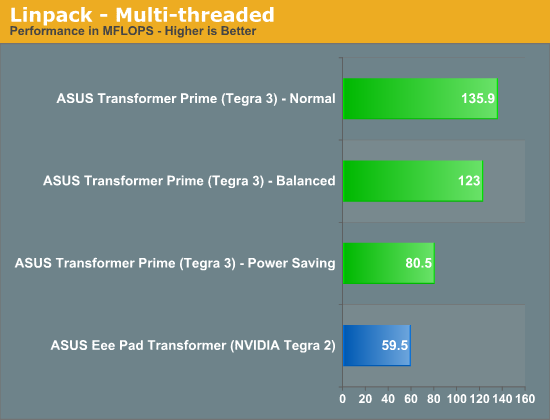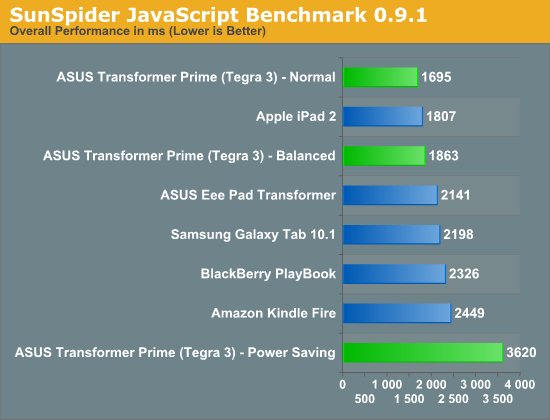ASUS Eee Pad Transformer Prime & NVIDIA Tegra 3 Review
by Anand Lal Shimpi on December 1, 2011 1:00 AM ESTCPU Performance
The big news with Tegra 3 is that you get four ARM Cortex A9 cores with NEON support instead of just two (sans NEON) in the case of the Tegra 2 or most other smartphone class SoCs. In the short period of time I had to test the tablet I couldn't draw many definitive conclusions but I did come away with some observations.
Linpack showed us healthy gains over Tegra 2 thanks to full NEON support in Tegra 3:


As expected, finding applications and usage models to task all four cores is pretty difficult. That being said, it's not hard to use the tablet in such a way that you do stress more than two cores. You won't see 100% CPU utilization across all four cores, but there will be a tangible benefit to having more than two. Whether or not the benefit is worth the cost in die area is irrelevant, it only means that NVIDIA (and/or its partners) have to pay more as the price of the end product to you is already pretty much capped.


The bigger benefit I saw to having four cores vs. two is that you're pretty much never CPU limited in anything you do when multitasking. Per core performance can always go up but I found myself bound either by the broken WiFi or NAND speed. In fact, the only thing that would bring the Prime to a halt was if I happened to be doing a lot of writing to NAND over USB. Keyboard and touch interrupts were a low priority at that point, something I hope to see addressed as we are finally entering the era of performance good enough to bring on some I/O crushing multitasking workloads.

Despite having many cores at its disposal, NVIDIA appears to have erred on the side of caution when it comes to power consumption. While I often saw the third and fourth cores fire up when browsing the web or just using the tablet, NVIDIA did a good job of powering them down when their help wasn't needed. Furthermore, NVIDIA also seems to prefer running more cores at lower voltage/frequency settings than fewer cores at a higher point in the v/f curve. This makes sense given the non-linear relationship between voltage and power.
From a die area perspective I'm not entirely sure having four (technically, five) A9 cores is the best way to deliver high performance, but without a new microprocessor architecture it's surely more efficient than just ratcheting up clock speed. I plan on providing a more thorough look at Tegra 3 SoC performance as I spend more time with a fixed Prime, but my initial impressions are that the CPU performance isn't really holding the platform back.










204 Comments
View All Comments
Anand Lal Shimpi - Thursday, December 1, 2011 - link
It actually feels really good. Hold it one handed in landscape mode and you'll get tired quickly, use it in portrait and prop it up on your chest and it's golden. It's not too big and heavy but you just need to prop it up against something for extended use.Take care,
Anand
Sabresiberian - Thursday, December 1, 2011 - link
Still sounds awkward to me.This is the kind of thing that intrigues me though, when it comes to "tablets". I'm one of those people that doesn't get the tablet thing, but I'm curious. This would be a good way for me to try one out, if I had a spare $600+ anyway. Which I don't right now. I could check out the tablet, and use it as a netbook/ultrabook if I didn't like the tablet option.
Coolz toyz will grab us by the privates, even when we know better. Or think we do.
:D
ltcommanderdata - Thursday, December 1, 2011 - link
http://www.nvidia.com/content/PDF/tegra_white_pape...According to nVidia's documentation, Tegra 2's GPU only supported FP20 in the pixel shaders. Has this been improved in the Tegra 3? I believe at least FP24 is required to officially support DirectX 9, so remaining at FP20 would presumably prevent Tegra 3 from being supported in Windows 8. Unless Microsoft intends to make an exception?
Reikon - Thursday, December 1, 2011 - link
"The X button acts as a tap/click on an icon (yes, NVIDIA managed to pick a button that's not what Sony or Microsoft use as the accept button - I guess it avoids confusion or adds more confusion depending on who you ask)."I'm not sure I'm reading it correctly, but Sony actually uses X as the accept button. It's just not in the same place as the one on that Logitech controller.
Ric_Margiotta - Thursday, December 1, 2011 - link
Thanks for the detailed write up, Anand! I'm looking forward to picking up a Prime when they reach the UK in January.ATOmega - Thursday, December 1, 2011 - link
Thanks for getting the review out so quickly! Still hoping to hear more about GPS, but I realize it's tough to fit it all through in such a small window.I recently sold my iPad2 to cover some of the cost of pre-ordering this tablet. My biggest frustration to date has been having no viable Android tablet to date and being forced to us iOS in the meantime. I've never felt so emasculated by an operating system!
By most measures, it looks like the Transformer Prime is consistently equal if not slightly better in most regards to the iPad2. Bearing in mind that it runs at a higher resolution when comparing performance numbers.
I have to agree, anyone who has been on the fence over Android tablets can probably come down now. It will be a year at the very least until we see a similar combination of build quality, screen quality, performance, consistency, etc... for Android again.
steven75 - Saturday, December 3, 2011 - link
Now you get to feel emasculated by lack of software.ismailfaruqi - Thursday, December 1, 2011 - link
Anand, does Tegra 3 support OpenCL already?Loki726 - Thursday, December 1, 2011 - link
nope, not yetismailfaruqi - Thursday, December 1, 2011 - link
thanks, it seems so. How about ipad2's powervr?